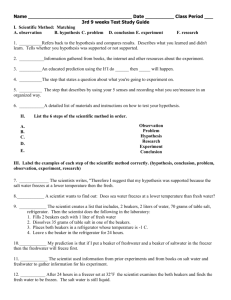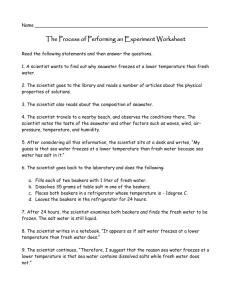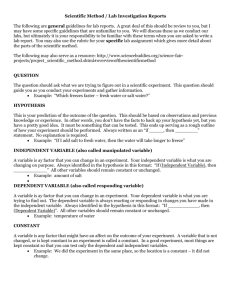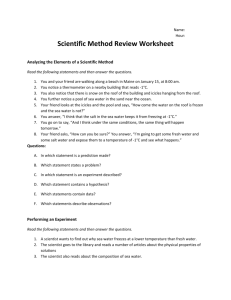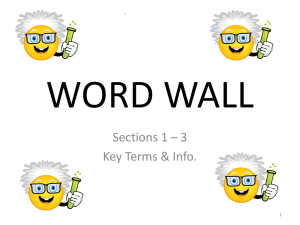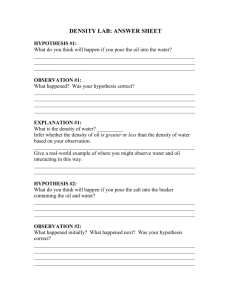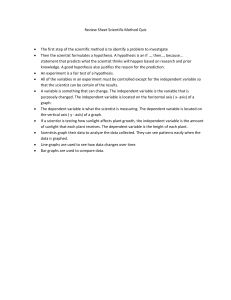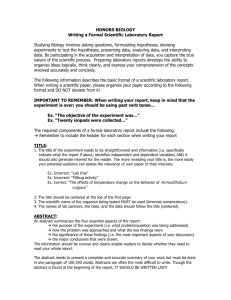Final Exam Study Guide
advertisement
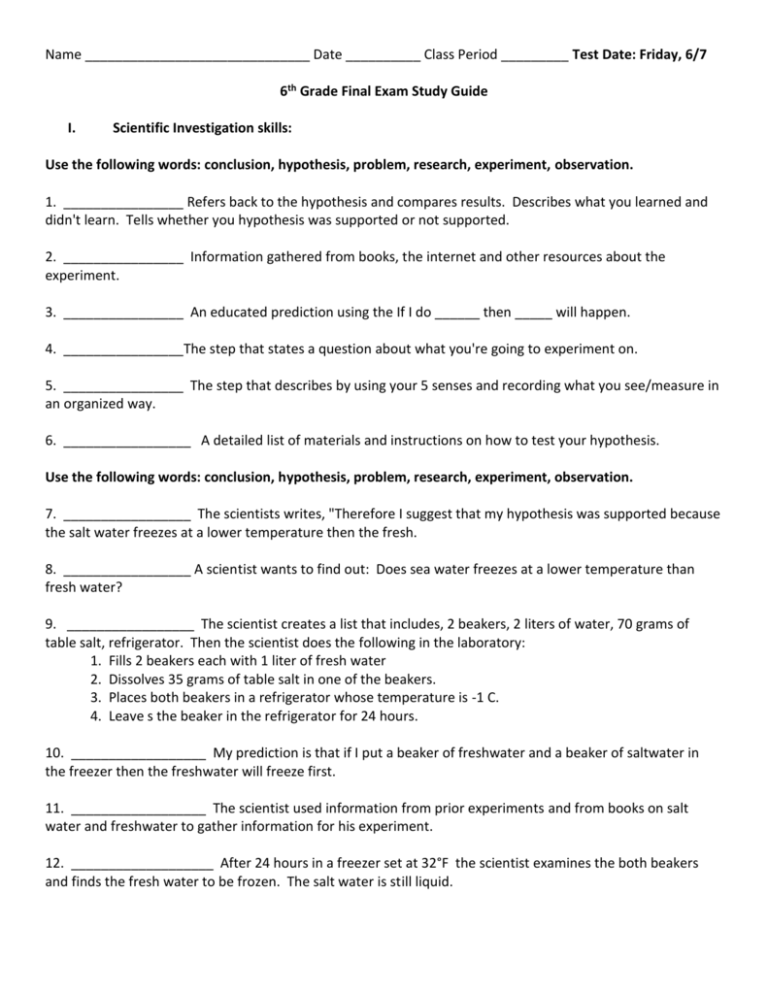
Name ______________________________ Date __________ Class Period _________ Test Date: Friday, 6/7 6th Grade Final Exam Study Guide I. Scientific Investigation skills: Use the following words: conclusion, hypothesis, problem, research, experiment, observation. 1. ________________ Refers back to the hypothesis and compares results. Describes what you learned and didn't learn. Tells whether you hypothesis was supported or not supported. 2. ________________ Information gathered from books, the internet and other resources about the experiment. 3. ________________ An educated prediction using the If I do ______ then _____ will happen. 4. ________________The step that states a question about what you're going to experiment on. 5. ________________ The step that describes by using your 5 senses and recording what you see/measure in an organized way. 6. _________________ A detailed list of materials and instructions on how to test your hypothesis. Use the following words: conclusion, hypothesis, problem, research, experiment, observation. 7. _________________ The scientists writes, "Therefore I suggest that my hypothesis was supported because the salt water freezes at a lower temperature then the fresh. 8. _________________ A scientist wants to find out: Does sea water freezes at a lower temperature than fresh water? 9. _________________ The scientist creates a list that includes, 2 beakers, 2 liters of water, 70 grams of table salt, refrigerator. Then the scientist does the following in the laboratory: 1. Fills 2 beakers each with 1 liter of fresh water 2. Dissolves 35 grams of table salt in one of the beakers. 3. Places both beakers in a refrigerator whose temperature is -1 C. 4. Leave s the beaker in the refrigerator for 24 hours. 10. __________________ My prediction is that if I put a beaker of freshwater and a beaker of saltwater in the freezer then the freshwater will freeze first. 11. __________________ The scientist used information from prior experiments and from books on salt water and freshwater to gather information for his experiment. 12. ___________________ After 24 hours in a freezer set at 32°F the scientist examines the both beakers and finds the fresh water to be frozen. The salt water is still liquid. Label each example below with the correct measurements. 13. _____________ 14.______________ 15. _____________ 16. _____________ 17.______________ II. Our Solar System Use the following words: gravity, comet, meteor, asteroid, rotation, revolution, year, day, tides, one, mercury, Gemini, Apollo, Space Shuttle 20. __________ Chunks of metal or stone that orbit the sun freely, not in a group. 21. __________ Spheres of dusty ice that have a tail and orbit the sun freely. Their tails can be millions of miles long. 22. __________ Pieces of metal or stone that fall through the Earth's atmosphere and burn up. The burning material is often called a "shooting star". 23. __________ The force of attraction between objects. This causes the planets and other space objects to maintain their elliptical orbit around the sun. 24.___________ Space object made of rock, metal or a combination of the two. Most lie in a belt between Mars and Jupiter and can be quite large. 25. ____________ The amount of time it takes the Earth to revolve around the sun 1 time 26.____________ To orbit or move around another object. 27.____________ The amount of time it takes for the Earth to spin one time on its axis. 28.____________ To spin on an axis 29. ____________ The gravitational pull of the moon on the Earth’s oceans and other bodies of water. 30. ____________ Number of stars in our solar system. 31. _____________ Space program that flew astronauts to the moon to explore the moon. (1965-1972) 32. _____________ First space program to launch humans on rockets. (1940-1950’s) 33. _____________ Space program that practice traveling in space & docking rockets. 34. _____________ Space program that used a reusable, plane like rocket. Use to carry large objects/conduct experiments. 35. Label the picture day & night. 36. Label summer, fall, winter & spring. 37. Label the moon phases. 38. Write the 8 planets in order from the sun. 39. Which 4 planets are big, gassy, have many moons, & long years because of their distance from the sun? The Sun: a) b) 40. Which 4 planets are smaller, rocky, few moons, and shorter years because they are closer to the sun? c) d) e) f) g) h) III. Matter Vocabulary review: atoms, elements, subatomic particles, nucleus, shells 41. ______________________ are the 3 smaller pieces found inside an atom. 42. ______________________ are the building block of matter/smallest part of matter. 43. ______________________ are pure substances made of only one type of atom. 44. ______________________ is the heavy center of the atom. 45. ______________________ energy levels around the nucleus where electrons are moving. Vocabulary review: proton, electron, neutron, L shell, M shell, K shell 46. _______________________ holds 2 electrons. 47. _______________________ is the positive subatomic particle found in the nucleus. 48. ______________________ holds 8 electrons. 49. ______________________ is the negative subatomic particle found outside the nucleus. 50.______________________ holds 18 electrons. Vocabulary review: element symbol, atomic number, atomic mass, proton, electron, neutron, element symbol, atomic number, atomic mass, element name 51._______________ number that tells the number of protons PLUS neutrons. 52. _______________ letter(s) that chemically represent each element 53. _______________ number that tells the number of protons and electrons. 54. _______________ 55. _______________ 56. _______________ 57. ________________ 57. 58. ________________ 59. ________________ 60. ________________ 58. 59. 60. IV. Energy Use the following words: renewable, transformation, biomass, the sun, geothermal, solar, kinetic, potential, fossil fuels, chemical, wind, hydropower, non-renewable 61. ___________________stored energy of position or structure 61. ___________________energy of motion or movement 63. __________________ Energy that was created from dead plants/animals that were under heat and pressure for millions of years. Coal, oil, gas were created into hydrocarbons that can be used as fuel. 64. __________________energy that comes directly from the sun. 65. __________________energy that hasn't been used yet. Batteries, food, and wood are examples. Energy is release when bonds between atoms are broken. 66. __________________ energy that comes from water heated by hot magma inside the Earth. Usually creates steam to turn a turbine. 67. __________________energy created from the uneven heating of the Earth's surface. 68. __________________energy created from the burning of plant material, animal waste, trash and wood. Often a methane gas is released that can be used as a fuel. 69. __________________energy created by moving water. Usually involves dams on rivers. 70. __________________how energy changes from one type of energy to another. 71. _________________energy that can be recycle/reused again and again. Includes solar, wind, hydropower, geothermal, and bio-mass energy. 72. __________________energy that cannot be recycled or reused. The Earth will eventually run out of these fossil fuels. 73. __________________ Source of all energy sources except geothermal & nuclear. 74. What are the 5 renewable energy sources? 75. What are the 4 non-renewable. 76. Write the energy transformation for the following object V. - Heat in Our atmosphere Write the correct word for each definition. Use: conduction, convection, radiation, convection currents 77.) ____________________________ The process of warm air rising, cold air sinking in a repeated pattern. 78.) ______________________________ heat transferred though a liquid or a gas 79.) ______________________________ heat transferred directly from one solid to the next through direct contact. 80.) ______________________________ heat transferred through electromagnetic waves Write the correct word for each definition. Use: The Earth’s energy budget, wind, Greenhouse effect, The sun, greenhouse gases 81.) _________________________ The concept that certain gases trap heat in our atmosphere. 82.) __________________________ This is responsible for powering the atmosphere, oceans, causing weather, providing heat, light, energy, and causing life processes. 83.) __________________________ The unequal heating and cooling of land and water that causes air to move. 84.) __________________________ The concept that energy in our atmosphere is balanced by being absorbed and reflected. 85.) __________________________ methane, water vapor, carbon dioxide 86. Draw and label an illustration of warm air and cold air for each box. Beside each box tell 3 facts. Cold Warm a.___________________ d. _______________ b. ___________________ e. _______________ c. ___________________ f. _______________ 87 VI. Water & Watersheds Use the following words: surface tension, water, adhesion, polor, cohesion, hydrogen & oxygen, condensation, hydrogen, oxygen, positive, positive, negative 88. ____________ _____________The two elements that make up water. 89. ___________________ The act of water molecules sticking together. 90. ___________________The Universal Solvent 91.____________________ The act of water sticking to other substances. 92. ____________________ The act of cohesion forming a “skin” on the surface of water. 93. ______________________The process of water vapor turning into a liquid when cooling. 94. _____________________ The process of water changing from a liquid to a gas when heat is added. 95. ____________________ Water is considered this because it has a 2 positive and a negative end. 96. ______________________ 96 97. ______________________ 98 97 99 98. ______________________ 99. ______________________ 100. ______________________ 100 101. ______________________ 101 102. Why does ice float? Use the following words: macroinvertebrates, biotic, abiotic, topographic, pollutant, divides, estuary, tributary, watershed, ecosystem 103. _________________A system formed by interactions between a community of living and non-living things in an environment. 104. ___________________All the land that drains water into a waterway. 105. ____________________A body of water that contributes its flow to a large body of water. 106. ____________________A partially enclosed body of water where freshwater and salt water mix. Along coastlines and the Chesapeake Bay is the largest in North America. 107. _____________________Points of higher ground that separate different watersheds. 108. _____________________Substance that contaminates/harms the environment. 109. _____________________A map that shows the land features of an area. 110. _____________________The factors in an ecosystem that are not living; water, sun, air, land. 111. _____________________The factors in an ecosystem that are living-plants, animals, insects. 112. _____________________Small animals without backbones, includes insects, larvae, snails and clams. A good indication of good water quality.

